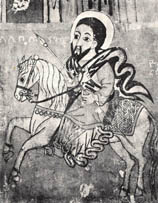Classic DACB Collection
All articles created or submitted in the first twenty years of the project, from 1995 to 2015.Lalibala (B)

Lalibäla, Emperor, of the Zagwé dynasty is recognized as a saint by the Ethiopian Church and commemorated on 12 Säné ( 19 June). Son of a nobleman, possibly an Emperor, Zan-Seyum, and cousin of Emperor Yemrehannä-Krestos, Laibäla was the most outstanding member of the dynasty which ruled Ethiopia in the twelfth and thirteenth centuries. His father’s name also appears as Šanuda in the History of the Patriarchs of Alexandria. He was born in Roha, Lasta, at the beginning of the reign of Emperor Harbay, his half-brother, and his mother gave him the name Lalibäla (which appears to signify “Bees have acknowledged his supremacy”) in recognition of a sign shown at his birth when a swarm of bees alighted on him. While still a boy, Lalibäla heard the voice of God telling him to build rock-churches at Roha - later his capital and now bearing his name, Lalibäla - finer even than those already hewn in Lasta or Tegré; to be able to create these, he must become Emperor.
When he reached manhood, Lalibäla decided to become a hermit in the mountainous regions of Tegré, to escape the persecutions of his half-brother Harbay who feared him as a rival for the throne. There Lalibäla met his future consort, the devout and gentle Mäsqäl-Kebra. Shortly after, he is said to have made the difficult pilgrimage to the Holy Land, which had been since 1099 in the hands of the Crusaders, and thus experienced at first hand the dangers and difficulties to which Ethiopian pilgrims were customarily exposed. At the same period, Harbay sent two missions to Rome, probably in response to the proposal of an alliance which Pope Alexader III had sent to the sovereign of Ethiopia in 1177; Alexander hoped that in the person of the Emperor of Ethiopia he had at last discovered “Prester John.”
On his return to Ethiopia, Lalibäla made a successful “march on Roha.” Tradition holds that Harbay abdicated in favour of his half-brother, acknowledging this to be the will of God. It seems likely that Lalibäla had the support of the Ethiopian clergy, who were doubtless opposed to a Papal alliance. On ascending the throne Lalibäla took the throne name Gäbrä-Mäsquäl. The new Emperor then put into practice his Christian ideals of voluntary poverty and charity towards all, even to his enemies, except when forced from time to time to defend the frontiers of the Empire, which was at this time apparently composed of the areas covered by the present-day provinces of Eritrea, Tegré, Wällo and northern Šäwa. The principle threats facing it were from the Muslims chiefs on the east and southeast, and the pagan tribes west of the Täkkäzé river. Within the Empire, Lalibäla had to deal with rebellious factions including jealous Aksumites and ambitious Šäwans. To achieve this, he made sure of the support of the monastery of Däbrä Libanos of Šimazana in Tegré, west of Addigrat, conferring special privileges on its clergy in 1205 and in 1255. In the south, he took possessions of the natural fortress of Amba Gešan in Amhara and founded a monastery there.
In his relations with Egypt, Lalibäla adopted a policy of “peaceful co-existence,” most likely to serve the interests of the Christians of the Orthodox Church in Ethiopia, Egypt and Palestine, especially since Sultan Salah al-Din (r. 1137-93) had conquered Jerusalem in 1187. The policy was successful, for in 1203, at the Emperor’s request, the Sultan of Egypt intervened in favour of the Ethiopian monks in the Holy Land. Harmony with Egypt, maintained through an exchange of embassies, letters and gifts, not only favoured commerce but meant that a new abun could be brought from Alexandria when necessity arose, for example Abunä Mika’él of Fua.
Arabic sources state that Lalibäla had two sons, Yetbaräk (later Emperor) and Anab or Atab. The former is believed to have been the last Zagwé ruler, though Ethiopian tradition states that Lalibäla did not wish his son to inherit his throne, and that he was succeeded by his nephew, Emperor Nä’akweto-Lä’ab, with whom Anab has been tentatively identified.
The greatest testimony to Lalibäla’s fame is the magnificent series of monolithic churches in his capital, hewn in the natural rock to design revealed to the Emperor in heaven during a vision, according to hagiographic tradition. This complex, including a honeycomb of underground corridors, trenches, stairways and inner courts, complete with a water system, represents the culminating point of the best Ethiopian architectural tradition.
Roger Sauter
Bibliography
J. Perruchon, Vie de Lalibala (Paris, 1892).
C. Conti Rossini, “L’evangelo d’oro di Dabra Libanos,” Rendiconti della Reale Accademia dei Lincei, Serie quinta, Vol. X (1901): 177-219.
——–, Storia d’Etiopia (Bergamo, 1928), 306-16.
E. Renaudot, Historia Patriarcharum Alexandrinorum (Paris, 1717).
Abu Salih (B. T. A. Evetts, trans. and ed.), The Churches and Monasteries of Egypt and some neighbouring countries (Oxford, 1895), 284-90.
R. Sauter, “La vie de Saint-Lalibela,”L’Ethiopie d’Aujourd’hui le 24 juin 1955; les 1, 8, 15 et 22 juillet 1955.
Taddesse Tamrat, Church and State in Ethiopia 1270-1527 (Oxford, 1972), 25, 55, n.3, 59-64, 98, 115.
Sergew Hable-Selassie, Ancient and Medieval Ethiopian History to 1270 (Addis Ababa, 1972), 15, 208, 240-241, 265-183, 291.
This article is reproduced, with permission, from The Dictionary of Ethiopian Biography, Vol. 1 ‘From Early Times to the End of the Zagwé Dynasty c. 1270 A.D.,’ copyright © 1975, edited by Belaynesh Michael, S. Chojnacki and Richard Pankhurst, Institute of Ethiopian Studies, Addis Ababa, Ethiopia. All rights reserved.



